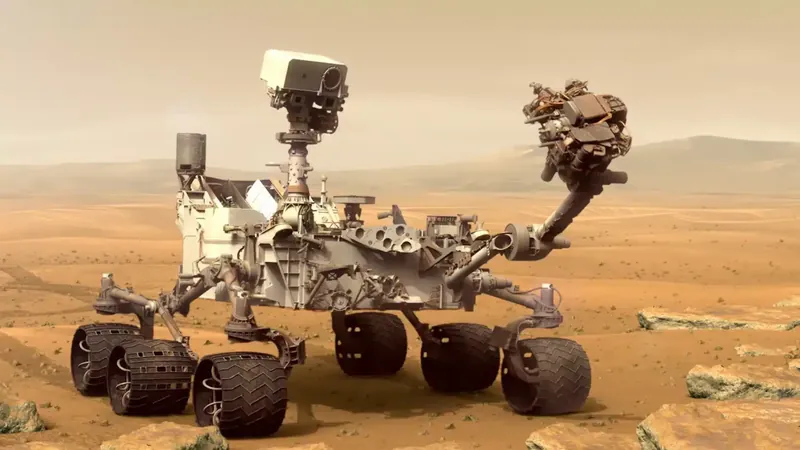
NASA's Curiosity Rover Makes Groundbreaking Discovery: Largest Organic Molecules Found on Mars!
2025-03-30
Author: Sophie
Unearthing Hidden Treasures
Back in 2013, the Curiosity rover drilled into a site called "Cumberland" within Gale Crater, a location that was once an ancient lakebed. This mudstone region had been submerged underwater for millions of years, creating an ideal environment for organic molecules to concentrate and remain preserved.
Years later, scientists revisited this sample and made a stunning discovery: traces of decane, undecane, and dodecane—long-chain organic molecules made up of 10, 11, and 12 carbon atoms.
"This is truly akin to looking for a needle in a haystack," stated Daniel Glavin, an astrobiologist at NASA. "And now we’ve found three needles!" This exciting find points to the progression of prebiotic chemistry on Mars that may have been more advanced than previously recognized.
Important Implications for Mars’ Chemistry
While these organic molecules do not directly confirm the existence of life, they strongly suggest that Mars was once more chemically complex. Fatty acids, the likely precursors of these alkanes, are essential components of cellular membranes on Earth, providing an intriguing link to biological processes.
Caroline Freissinet, the study's lead author, emphasized, “We could still identify signatures of past life by analyzing Martian samples.” This supports ongoing interest in Mars’s potential habitability in its geological history.
Revisiting the Data
Curiosity’s onboard chemistry lab, known as SAM (Sample Analysis at Mars), has been vital yet faced challenges due to the intricacies of interpreting Martian data. The team persisted, analyzing the Cumberland sample multiple times.
Surprisingly, through detailed analyses of data that had previously appeared ambiguous, they confirmed the presence of these long-chain organic molecules.
Simulating Martian conditions back in the lab allowed researchers to see how similar organic molecules might behave, further solidifying their findings.
The Eternal Mystery of Life's Origins
Despite the excitement surrounding these discoveries, scientists are cautious. The hydrocarbons found—like undecane—could potentially stem from non-biological processes. For instance, meteoric impacts may have introduced these fatty acids to Mars.
Alternatively, they could be remnants from more complex geological processes.
As Freissinet highlighted, the SAM data has its hurdles, but there's still untapped potential within the remaining sample from Cumberland. Researchers are planning to adjust their methods to explore smaller alkanes that could yield more data about their origin.
Surprising Preservation
What makes this discovery even more astonishing is that these organic compounds survived the harsh Martian environment for billions of years. The presence of clay, sulfur, and nitrates is believed to have played a crucial role in preserving these molecules.
Clay minerals, for instance, are known to protect organic matters, while sulfur can enhance molecular stability.
Mars's history of liquid water in Gale Crater may have provided an extended timeframe for the conditions necessary for life-forming chemistry.
Looking Ahead
The next phase of exploration aims to return these Martian samples to Earth, where advanced laboratory tools can reveal deeper insights into the planet’s past. NASA's Perseverance rover is already in action collecting rock samples for such a future mission.
Experts speculate that these long-chain organics might be more prevalent on Mars than previously thought. The emerging knowledge around Curiosity’s findings expands our understanding of a planet that may have once possessed the essential conditions for life.
As Curiosity continues its journey, the ultimate objective remains clear: to unravel the mysteries of Mars and assess the implications of these organic discoveries. Are we on the verge of confirming Mars as a realm that once held life? Only time will tell, as each click of Curiosity’s wheels unearths new secrets of our cosmic neighbor!









 Brasil (PT)
Brasil (PT)
 Canada (EN)
Canada (EN)
 Chile (ES)
Chile (ES)
 Česko (CS)
Česko (CS)
 대한민국 (KO)
대한민국 (KO)
 España (ES)
España (ES)
 France (FR)
France (FR)
 Hong Kong (EN)
Hong Kong (EN)
 Italia (IT)
Italia (IT)
 日本 (JA)
日本 (JA)
 Magyarország (HU)
Magyarország (HU)
 Norge (NO)
Norge (NO)
 Polska (PL)
Polska (PL)
 Schweiz (DE)
Schweiz (DE)
 Singapore (EN)
Singapore (EN)
 Sverige (SV)
Sverige (SV)
 Suomi (FI)
Suomi (FI)
 Türkiye (TR)
Türkiye (TR)
 الإمارات العربية المتحدة (AR)
الإمارات العربية المتحدة (AR)